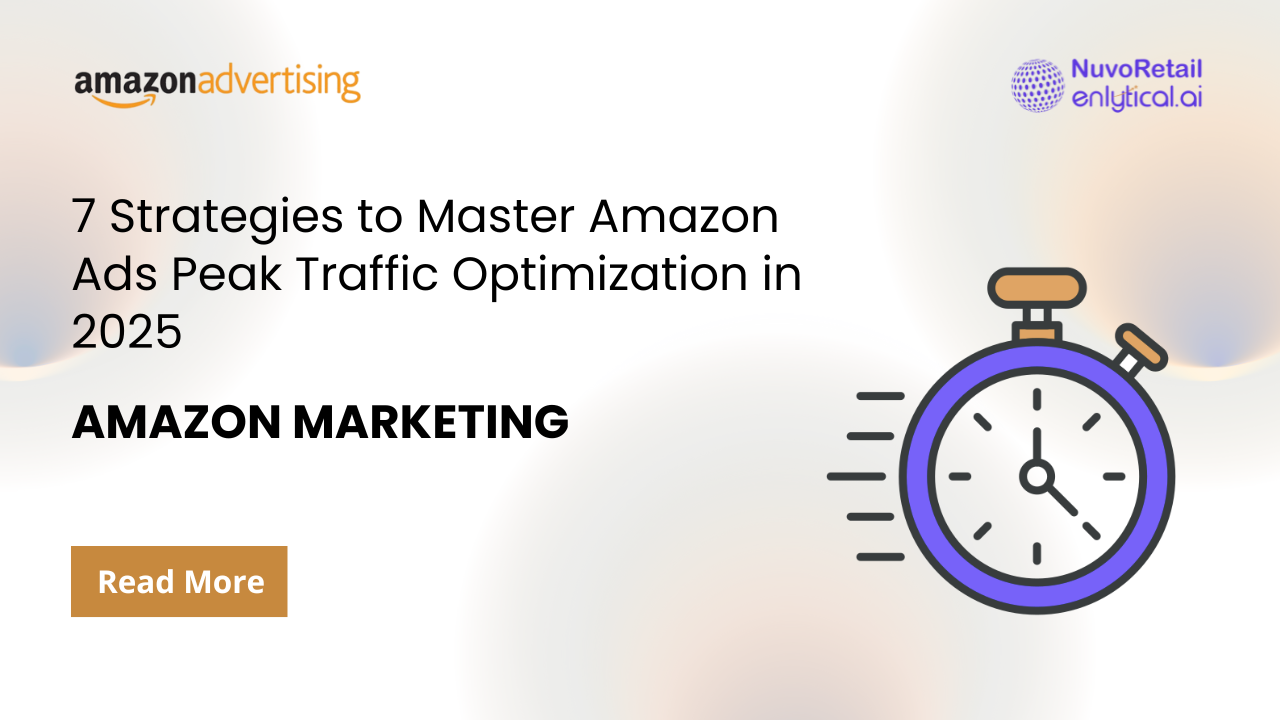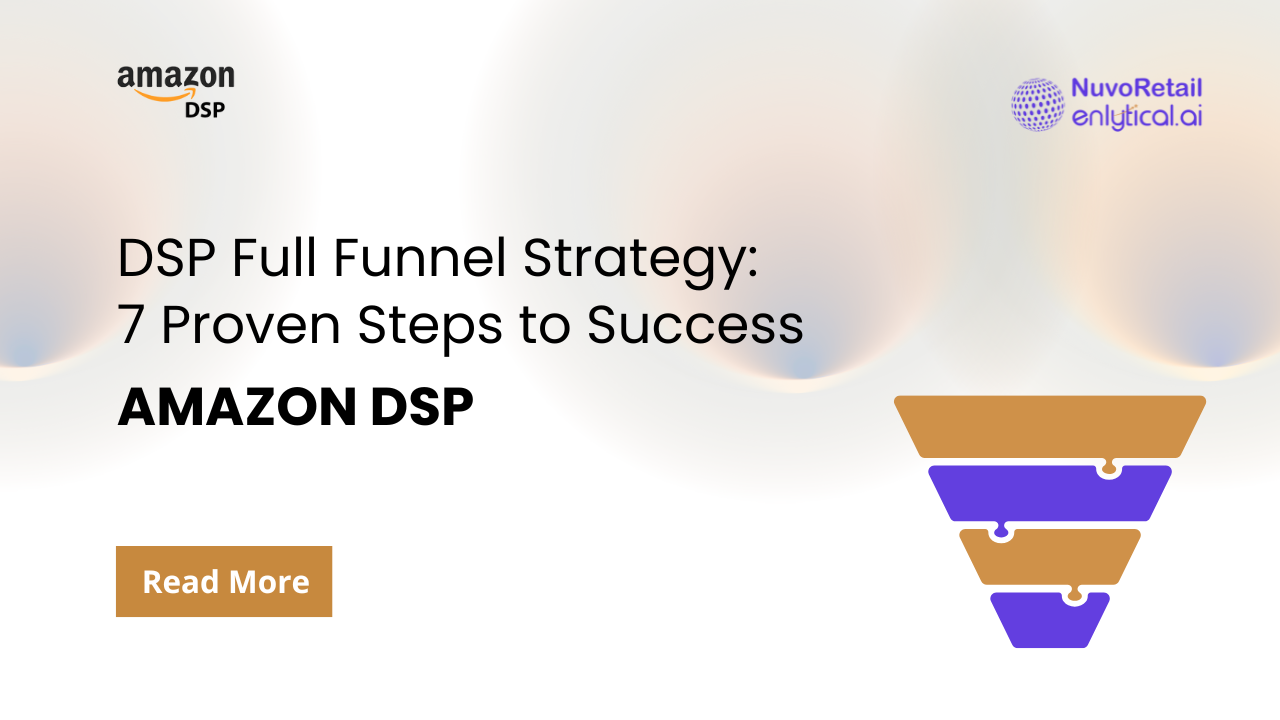Amazon Ads peak traffic optimization is the game-changer every e-commerce seller needs to maximize their advertising ROI. With millions of shoppers browsing Amazon during specific hours of the day, understanding when and how to reach them can dramatically impact your conversion rates and overall sales performance. Whether you’re running Sponsored Products, Sponsored Brands, or Sponsored Display campaigns, timing your ads to coincide with peak shopping hours is essential for staying competitive in today’s marketplace.
As e-commerce continues to evolve, sellers face increasing competition for customer attention. NuvoRetail specializes in helping brands navigate this complex landscape through comprehensive Amazon marketing services, including strategies tailored for Amazon Ads peak traffic optimization that drive measurable results. With deep expertise in amazon advertising strategies, data-driven campaign optimization, and performance analytics, NuvoRetail empowers sellers to maximize their visibility during critical shopping windows. Their team of specialists understands the nuances of Amazon Ads peak traffic optimization and works closely with clients to develop customized strategies that align with business goals and seasonal trends.
Table of Contents
- Understanding Amazon Peak Traffic Times
- Why Peak Hour Targeting Matters for Amazon Campaigns
- Strategy 1: Analyze Your Performance Data by Hour
- Strategy 2: Implement Dayparting and Bid Adjustments
- Strategy 3: Leverage Seasonal Peak Traffic Patterns
- Strategy 4: Optimize Ad Creative for Peak Hours
- Strategy 5: Use Amazon’s Campaign Scheduling Tools
- Strategy 6: Monitor and Adjust in Real-Time
- Strategy 7: Partner with an Amazon Ad Agency
- Conclusion
Understanding Amazon Peak Traffic Times
Peak traffic times on Amazon typically occur when the largest number of shoppers are actively browsing and making purchasing decisions. Research shows that amazon ads perform best during specific windows throughout the day and week. Understanding Amazon Ads peak traffic patterns is fundamental to campaign success.
Generally, peak hours on Amazon occur:
- Weekdays: 8-10 AM (morning commute), 12-2 PM (lunch break), and 7-10 PM (evening relaxation)
- Weekends: 10 AM-2 PM and 6-9 PM
- Special events: Prime Day, Great Indian Festival, Black Friday, holiday shopping seasons
Understanding these patterns is crucial for effective peak traffic optimization. However, your specific audience may have different behaviors based on your product category, price point, and target demographic.
According to Amazon’s advertising guide, traffic patterns can vary significantly during promotional events, making it essential to monitor your campaigns closely during these periods.
Why Peak Hour Targeting Matters for Amazon Campaigns
Optimizing your amazon advertising strategy around peak traffic delivers several critical advantages that directly impact your bottom line. When you align your amazon campaigns with high-traffic periods, you position your products in front of the largest possible audience at the most opportune moments.
Increased Visibility: More shoppers browsing means more potential impressions for your products. When you concentrate your ad spend during high-traffic windows, your products appear to a larger audience.
Better Conversion Rates: Shoppers during peak hours are often in “buying mode” – they’re actively searching with purchase intent rather than casual browsing.
Improved ROI: By focusing budget on times when conversion likelihood is highest, you reduce wasted ad spend during low-performance hours. Amazon Ads peak traffic strategies help you maximize every dollar invested.
Competitive Advantage: Many sellers don’t optimize for peak traffic times, giving you an edge when you strategically increase bids during these windows.
For brands looking to maximize their advertising on amazon, understanding these dynamics is fundamental to campaign success. NuvoRetail’s Amazon PPC strategies focus specifically on reducing wasted spend while boosting ROI through intelligent timing optimization.
Strategy 1: Analyze Your Performance Data by Hour
The foundation of effective Amazon Ads peak traffic optimization starts with comprehensive data analysis. Before making any changes to your amazon ads campaign, you need to understand your specific performance patterns and identify when your target audience is most active.
Steps to Analyze Your Data:
Access Hourly Reports: Navigate to your Amazon Advertising Console and generate reports segmented by hour of day. Amazon provides detailed performance metrics through their reporting tools.
Identify High-Performance Windows: Look for patterns in:
- Click-through rates (CTR)
- Conversion rates
- Advertising Cost of Sales (ACoS)
- Return on Ad Spend (ROAS)
Segment by Product Category: Different products may perform better at different times. Electronics might peak in the evening, while grocery items could surge during morning hours.
Consider Day of Week Variations: Weekend patterns often differ significantly from weekday traffic for amazon campaigns.
This analysis reveals your unique peak hour opportunities and provides the foundation for successful Amazon Ads peak traffic strategies.
Strategy 2: Implement Dayparting and Bid Adjustments
Dayparting is one of the most powerful tactics for Amazon Ads peak traffic optimization, allowing you to bid smarter during high-performing hours. This strategy allows you to be more aggressive during high-performing hours while conserving budget during slower periods.
How to Implement Effective Dayparting:
Manual Bid Adjustments: Increase bids by 20-50% during your identified peak hours to win more auctions and secure better ad placements for your amazon ads.
Use Automation Tools: Third-party tools can automatically adjust bids based on time-of-day performance, removing the need for constant manual oversight of your amazon campaigns.
Start Conservatively: Begin with modest 10-15% bid increases during peak windows, then gradually increase as you see positive results in your advertising on amazon.
Monitor ACoS Closely: Higher bids should still maintain profitable ACoS levels. If your cost per acquisition rises too much, scale back adjustments.
As noted by Marin Software’s optimization guide, applying strategic bid boosts during peak performance windows can significantly improve overall campaign efficiency.
Many successful sellers work with an amazon ad agency to implement sophisticated dayparting strategies that maximize Amazon Ads peak traffic opportunities.
Strategy 3: Leverage Seasonal Peak Traffic Patterns
Amazon Ads peak traffic isn’t just about hours of the day – it also includes seasonal shopping patterns and promotional events that dramatically increase Amazon traffic. Understanding these cyclical patterns helps you plan budget allocation months in advance.
Key Seasonal Opportunities:
Prime Day: Amazon’s flagship shopping event generates massive traffic spikes. Your amazon ads campaign should be heavily optimized for the days leading up to and during the event.
Holiday Shopping Season: November through December sees sustained high traffic. Plan increased budgets and aggressive bidding during this period for your amazon advertising.
Back-to-School: Late July through September drives strong peak traffic in relevant categories.
Category-Specific Peaks: Valentine’s Day for gifts, summer for outdoor products, January for fitness equipment.
NuvoRetail’s Great Indian Festival guide provides excellent insights into preparing for major sales events, with a focus on Amazon Ads peak traffic strategies for maximizing seasonal performance.
Preparation Tips:
Start planning 4-6 weeks before major events. Increase budgets gradually to capture early shoppers. Test creative variations to identify top performers. Ensure inventory levels can support increased demand during peak traffic times.
Strategy 4: Optimize Ad Creative for Peak Hours
Your ad creative should align with shopper mindset during different peak hours. Evening shoppers may respond to different messaging than lunch-break browsers, and your Amazon Ads peak traffic strategy should account for these behavioral differences.
Creative Optimization Tactics:
Time-Relevant Messaging: Consider using dynamic creative that references time of day (“Perfect for tonight’s dinner” during evening hours).
Highlight Fast Delivery: During peak shopping times, emphasize Prime shipping and quick delivery to capture impulse buyers browsing amazon ads.
Urgency Elements: Limited-time offers and countdown timers work especially well during high-traffic periods.
Mobile Optimization: Much peak traffic comes from mobile devices – ensure your listings and images are mobile-friendly.
Strong product discoverability is crucial during Amazon Ads peak traffic periods, when competition is highest. Learn more about increasing product discoverability on Amazon to ensure your optimized ads lead to compelling product pages.
Strategy 5: Use Amazon’s Campaign Scheduling Tools
Amazon provides native tools within their advertising platform to help manage amazon advertising during optimal times. These tools, when used effectively, can automate many aspects of Amazon Ads peak traffic optimization.
Available Amazon Tools:
Campaign Scheduling: Set specific start and end dates for campaigns tied to promotional events.
Budget Pacing: Amazon’s system can help distribute your daily budget more effectively across peak and off-peak hours.
Automated Bidding Strategies: Dynamic bidding options adjust in real-time based on conversion likelihood during peak hour shopping.
Portfolio Management: Group campaigns to manage budgets across multiple products simultaneously.
While Amazon’s native tools provide a solid foundation, working with an amazon advertising agency can unlock advanced strategies and third-party technologies that provide even greater control over timing optimization for your amazon campaigns.
Strategy 6: Monitor and Adjust in Real-Time
The most successful amazon campaigns don’t rely on “set it and forget it” approaches. Real-time monitoring allows you to capitalize on unexpected traffic spikes and quickly address underperforming periods in your Amazon Ads peak traffic strategy.
Real-Time Monitoring Best Practices:
Set Up Alerts: Configure notifications for significant metric changes – dramatic increases in ACoS or drops in impressions during peak traffic times.
Check Performance Multiple Times Daily: During peak seasons, review campaign performance 2-3 times per day.
Quick Response Protocol: Have a clear process for making rapid bid adjustments when you spot opportunities or issues in your amazon ads.
Competitive Monitoring: Watch what competitors are doing during peak periods and adjust your strategy accordingly.
Test Continuously: Run A/B tests even during peak periods to identify incremental improvements in your advertising on amazon.
Regular monitoring ensures you’re not missing emerging peak traffic patterns that could benefit your amazon ads performance.
Strategy 7: Partner with an Amazon Ad Agency
Managing sophisticated Amazon Ads peak traffic optimization strategies requires significant time, expertise, and resources. Many successful sellers partner with an amazon marketing agency to maximize their advertising performance during critical shopping windows.
Benefits of Agency Partnership:
Expert Knowledge: Agencies like NuvoRetail bring deep expertise in amazon advertising trends and best practices for peak traffic optimization.
Advanced Tools: Access to premium software and analytics platforms that provide deeper insights into Amazon Ads peak traffic patterns.
Time Savings: Free up your team to focus on product development, inventory management, and customer service while experts handle your amazon campaigns.
Scalability: Agencies can quickly scale campaigns up or down based on performance and seasonal demands.
Strategic Planning: Develop comprehensive strategies that align advertising with broader business objectives.
A specialized amazon ad agency understands the complexities of peak hour optimization and can implement sophisticated Amazon Ads peak traffic strategies that would be difficult to execute in-house.
Conclusion
Mastering Amazon Ads peak traffic optimization is essential for maximizing your advertising ROI in today’s competitive marketplace. By analyzing performance data, implementing strategic dayparting, leveraging seasonal patterns, optimizing creative, using Amazon’s tools, monitoring in real-time, and potentially partnering with experts, you can ensure your products reach shoppers when they’re most ready to buy.
The key to success lies in understanding your unique Amazon Ads peak traffic times and continuously refining your approach based on performance data. Whether you manage campaigns in-house or work with an amazon advertising agency, the strategies outlined in this guide provide a roadmap for capturing more sales during critical high-traffic windows.
Remember that peak traffic optimization is an ongoing process, not a one-time setup. As consumer behavior evolves and Amazon’s platform changes, your Amazon Ads peak traffic strategies must adapt to maintain competitive advantage and deliver consistent results.
Ready to Optimize Your Amazon Ads for Peak Performance?
Don’t let peak shopping hours slip away with ads that aren’t performing their best. At NuvoRetail, our Amazon marketing services are designed to help sellers like you maximize visibility, increase conversions, and scale sustainably even during the busiest traffic periods. From campaign optimization to advanced performance tracking, our team ensures your Amazon ads are working as hard as possible for your business.
If you’re ready to see better results, get in touch with us today. We’d love to walk you through how NuvoRetail can optimize your campaigns for maximum impact and long-term growth.
And while you’re here, share this guide with other Amazon sellers who might benefit. Plus, let us know in the comments – what’s your biggest challenge when managing Amazon ads during high-traffic periods?




